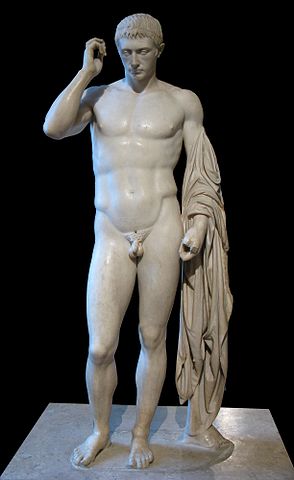User:PatJosephK/sandbox

Heroic nudity or ideal nudity is a concept in classical scholarship to describe the use of nudity in classical sculpture to indicate that a sculpture's apparently mortal human subject is in fact a hero or semi-divine being. This convention began in archaic and classical Greece and was later adopted by Hellenistic and Roman sculpture. Nudity was often thought to be an important aspect of Greek civilization and was frequent in places such as gymnasiums and when competing in games.[1] This concept operated for women as well as for men, with females being portrayed through Venus and other goddesses.[2] Particularly in Roman examples like the Tivoli General or Delos "Pseudo-Athlete", this could lead to an odd juxtaposition of a hyper-realistic portrait bust in the Roman style (warts-and-all for the men, or with an elaborate hairstyle for the women) with an idealized god-like body in the Greek style. Male genitalia explicitly were not depicted as overly well-endowed to separate a noble and modest facade from the connotation in Greek culture that larger endowments belonged to more primal and barbaric characteristics.[3]
As a concept, it has been modified since its inception, with other types of nudity now recognized in classical sculpture—e.g., the pathetic nudity of brave but defeated barbarian enemies like the Dying Gaul.[4] Tonio Hölscher has even rejected the concept entirely for Greek art of the 4th century BC and earlier.
Heroic nudity allowed Greek sculptors to show a subject's character more accurately, without the disguise or added context of clothing. [5]

-
A Seleucid prince depicted in heroic nudity, National Museum of Rome
-
Roman statue with the head of Marcellus (1st century CE, after a 5th-century BC Greek prototype)
-
Antonio Canova: Napoleon as Mars the Peacemaker (1802-1806) - Napoléon en Mars désarmé et pacificateur, Apsley House, London

Types of Nudity
[edit]As a concept, it has been modified since its inception, with other types of nudity now recognized in classical sculpture—e.g., the pathetic nudity of brave but defeated barbarian enemies like the Dying Gaul. Tonio Hölscher has even rejected the concept entirely for Greek art of the 4th century BC and earlier.
Athletic examples of nudity drew upon the
Heroic nudity allowed Greek sculptors to show a subject's character more accurately, without the disguise or added context of clothing.
Civic or Democratic nudity
The Nature of "Nakedness"
[edit]Erotic or licentious nudity was
Mundane nudity, or
things to edit:
- arrange the photographs/images to be more visually appealing
Different types of nudity:
- Athletic nudity
- Democratic/civic nudity
- Heroic nudity
The nature of "Nakedness":
- Erotic/licentious nudity
- Mundane nudity
- Brutish nudity
Nudity in different ancient classical cultures
[edit]Etruscan
[edit]The Etruscan ideals of nudity were more of an influence from the neighboring Greeks, in that they reluctantly accepted and embraced it through the Greeks.[6] The connotations for most nudity was reserved for criminals, slaves, and prisoners.[6]
Greek
[edit]Greek culture in early development was a shameful aspect to
Roman
[edit]Bibliography:
Bonfante, Larissa. "ETRUSCAN NUDITY." Source: Notes in the History of Art 12, no. 2 (1993): 47-55. http://www.jstor.org/stable/23202935.
Bonfante, Larissa. "Nudity as a Costume in Classical Art." American Journal of Archaeology 93, no. 4 (1989): 543-70. doi:10.2307/505328.
Bonfante, Larissa. "The NAKED GREEK." Archaeology 43, no. 5 (1990): 28-35. http://www.jstor.org/stable/41765856.
SPIVEY, NIGEL. “Art and Archaeology.” Greece and Rome 53, no. 1 (2006): 126–28. doi:10.1017/S0017383506000118.
WINFIELD, Richard Dien. "THE CLASSICAL NUDE AND THE LIMITS OF SCULPTURE." Revue Internationale De Philosophie 56, no. 221 (3) (2002): 443-60. http://www.jstor.org/stable/23955563.
Zuckert, Rachel. "Sculpture and Touch: Herder's Aesthetics of Sculpture." The Journal of Aesthetics and Art Criticism 67, no. 3 (2009): 285-99. http://www.jstor.org/stable/25622078.
Notes and references
[edit]- ^ Spivey, Nigel (1996). Understanding Greek Sculpture. Thames & Hudson. p. 111. ISBN 0500278768.
- ^ "Trajanic woman as Venus (Capitoline Museums)".
- ^ Spivey, Nigel. Understanding Greek Sculpture. p. 112.
- ^ Hallett 2005, p. 10.
- ^ Spivey, Nigel. Understanding Greek Sculpture (PDF). pp. 111–112.
- ^ a b Bonfante, Larissa (Winter 1993). "ETRUSCAN NUDITY". Source: Notes in the History of Art, Vol. 12, No. 2, ESSAYS ON NUDITY INANTIQUITY IN MEMORY OF OTTO BRENDEL: 47–55 – via JSTOR.
 | This is a user sandbox of PatJosephK. You can use it for testing or practicing edits. This is not the sandbox where you should draft your assigned article for a dashboard.wikiedu.org course. To find the right sandbox for your assignment, visit your Dashboard course page and follow the Sandbox Draft link for your assigned article in the My Articles section. |




